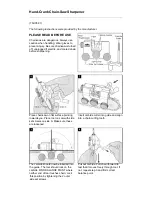
Safety
Precautions
Section 1
6
FALLING UNITS CAN CAUSE INJURY -
1) Use lifting aid to lift unit from bottom or handles, NOT
running gear, gas cylinders or any other accessories.
2) Use equipment of adequate capacity to lift and support unit.
3) If using lift forks to move unit, be sure forks are long enough
to extend beyond opposite side of the unit.
OVERUSE CAN CAUSE OVERHEATING -
1) Allow cooling period; follow rated duty cycle.
2) Reduce current or reduce duty cycle before starting to weld
again.
3) Do not block or filter airflow to unit
STATIC (ESD) CAN DAMAGE PC BOARDS -
1) Put on grounded wrist strap BEFORE handling boards or
parts.
2) Use proper static-proof bags and boxes to store, move or
ship PC boards.
MOVING PARTS CAN CAUSE INJURY -
1) Keep hands, hair, loose clothing and tools away from
moving parts such as fans and pinch points such as drive
rolls.
2) Keep all doors, panels, covers and guards closed and
securely in place.
3) Always disconnect electrical power prior to service to
prevent the fan from starting unexpectedly.
WELDING WIRE CAN CAUSE INJURY -
1) Do not press weld tool (gun) trigger until instructed to do
so.
2) Do not point weld tool toward any part of the body, other
people or any metal when threading welding wire.
H.F. RADIATION CAN CAUSE INTERFERENCE -
1) High-Frequency (H.F.) can interfere with radio navigation,
safety services, computers and communications equipment.
2) Have only qualified persons familiar with electronic
equipment perform this installation.
3) The user is responsible for having a qualified electrician
promptly correct any interference problem resulting from the
installation.
4)
If notified by the FCC about interference, stop using the equipment at once.
5)
Have the installation regularly checked and maintained.
6)
Keep high-frequency source doors and panels tightly shut, keep spark gaps at
correct setting, and use grounding and shielding to minimize the possibility of
interference.
ARC WELDING CAN CAUSE INTERFERENCE -
1) Electromagnetic energy can interfere with sensitive electronic
equipment such as computers and computer-driven
equipment such as robots.
2) Be sure all equipment in the welding area is electro-
magnetically compatible.
3) To reduce possible interference, keep weld cables as short as
possible, close together, and down low, such as on the floor.
4)
Locate welding operation 100 meters from any sensitive electronic equipment.
5)
Be sure this welding machine is installed and grounded according to this
manual.
6)
If interference still occurs, the user must take extra measures such as moving
the welding machine, using shielded cables, using line filters, or shielding the
work area.
EMF Information
Considerations about welding and the effects of low frequency Electric and Magnetic
Fields (EMF):
Welding current, as it flows through welding cables, will create electromagnetic
fields. There has been and still is some concern about such fields. However, after
examining more than 500 studies spanning 17 years of research, a special blue ribbon
committee of the National Research Council concluded that: “The body of evidence,
in the committee’s judgement, has not demonstrated that exposure to power-
frequency electric and magnetic fields is a human-health hazard.” However, studies
are still going forth and evidence continues to be examined. Until the final
conclusions of the research are reached, you may wish to minimize your exposure to
electromagnetic fields when welding or cutting. See section on EMF on page 4.
HOT PARTS CAN CAUSE SEVERE BURNS -
1) Do not touch hot parts with bare hands.
2) Allow cooling period before working on welding tool (weld
tool or torch).
E Q U I P M E N T M A I N T E N A N C E -
Faulty or improperly maintained equipment can cause injury or
death. Therefore:
1) Always have qualified personnel perform the installation,
troubleshooting, and maintenance work. Do not perform
any electrical work unless you are qualified to do the work.
2)
Before performing any work inside a power source, disconnect the power
source from the incoming electrical power using the disconnect switch at the
fuse box before working on the equipment.
3)
Maintain cables, grounding wire, connections, power cord, and power supply
in safe working order. Do not operate any equipment in faulty condition.
4)
Do not abuse any equipment or accessories. Keep equipment away from: -
heat sources such as furnaces
- wet conditions such as water puddles and inclement weather -
oil or grease
- corrosive atmospheres.
5)
Keep all safety devices and cabinet covers in position and in good repair.
6)
Use equipment only for its intended purpose. Do not modify it in any
manner.
Summary of Contents for QuikLinx 10700
Page 9: ...Safety Precautions Section 1 8 Symbols and Definitions ...
Page 28: ...Section 2 Section 7 Exploded Diagram 27 Figure 21 1 9 8 12 13 4 5 7 6 10 11 3 2 ...
Page 30: ...Section 2 Section 7 Exploded Diagram 29 Figure 22 5 1 2 3 4 ...
Page 32: ...Please visit us on the web www imageindustries com twitter studwelding ...








































